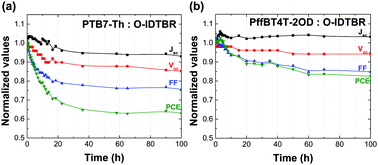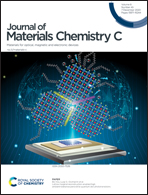Effects of polymer crystallinity on non-fullerene acceptor based organic solar cell photostability†
Abstract
While there has been rapid progress made in the performance of organic photovoltaic (OPV) cells in recent years, the device stability remains a major bottleneck for commercialization. In this work, we blended a stable acceptor (O-IDTBR) with two photostable donors (PTB7-Th and PffBT4T-2OD) having different polymer crystallinity, and the resulting devices show a significant difference in the OPV degradation rate. The OPV devices employing a highly crystalline polymer PffBT4T-2OD as an active layer show a good resistance against light soaking, maintaining 80% of the initial power conversion efficiency (PCE) up to 100 hours, while the devices employing an amorphous polymer PTB7-Th as an active layer show a significant PCE loss in the initial 20 hours mainly due to a rapid loss of the fill factor. By carrying out a comprehensive analysis of the device degradation mechanisms, we conclude that the origin for the PTB7-Th:O-IDTBR device degradation is the formation of mid-gap states under continuous sunlight illumination, leading to a significant drop in electron mobility. Device simulation revealed that deep traps act as charge recombination centers and increase the trap-assisted recombination rate, lowering the FF and Jsc.

- This article is part of the themed collection: Editor’s Choice: Organic Photovoltaics


 Please wait while we load your content...
Please wait while we load your content...
